-
2313
Software Architecture Patterns: Understand Method, Types, and Importance
Building software is never about just coding. It's a complex job containing several aspects; coding is just a tiny portion. Software architectural patterns are yet another crucial aspect that keeps the different parts of software interrelated.
Are you looking to build enterprise-level applications? Do you intend to make it robust and scalable? You need planning and the correct software architecture pattern. Your project may fail without the right software architecture, causing severe time, resources, and money loss. This article will help you understand many of your unsolved queries related to software architecture patterns and help you choose the right one.
When software, such as mobile or web applications, is built, they are meant to be productive, efficient, cost-effective, and scalable. Building quality software is nothing short of challenging, requiring engineers to follow a round of processes. Software architecture patterns help solve errors and build high-quality applications. It’s just like the software development process But, the questions you might have are;
- What is a software architecture pattern?
- What is the importance of software architecture patterns?
- How does it work?
- And what are the types of software architecture patterns?
In this article, we will explore all these questions and find valid answers.
Codzgarage is the leading software development company with core expertise in custom software development, application modernization and migration We help entrepreneurs, startups, or big enterprises create applications from scratch and migrate their legacy software to modern platforms. Contact us today with your project scope.
What are Software Architecture Patterns?
Software architecture is crucial to software development, ensuring a smooth data flow and correlations between data and program structures. The software remains efficient, reliable, and updatable with intact software architecture patterns.
It’s more about design related to the structure and behavior of the whole system. It functions just like the architectural pattern of a building that combines rooms, floors, and walls, making the different parts work together. The software also has many components that combine together to work as one. In software development, the architecture pattern guides engineers to build a robust and maintainable system.
The Significance of Software Architecture Patterns
When a team of software engineers starts building a complex software system, they need a roadmap. Software architecture patterns guide them, provide significant inputs so they make informed decisions, and produce outstanding applications that are quality proven, maintainable, and adaptive. Here are some of the top benefits of software architecture patterns in software development.
1: Defining Characteristics and Structure of Applications
Patterns provide a structured way to organize the different components and modules of a software system. With software architecture patterns creating a clear and logical layout is possible. When you have software architecture patterns in place, and you know the characteristic of each pattern, it helps you sketch out essential attributes, such as strengths and weaknesses of your application.
2: Models Reusability
While developing design patterns or writing programs, developers face similar problems time and time again. Patterns offer reusable solutions, such as repeatable design patterns that make it easier to solve everyday problems. Instead of reinventing the wheel each time, developers can use established patterns, saving time and effort.
3: Scalability
Software architecture pattern ensures your software do face scalability issue when your business grows. Many software architectural patterns are available which are designed with scalability in mind. When your business grows, you need to add new features and functionalities. The patterns will allow you to add them without causing significant disruptions.
4: Performance & Productivity
Software architecture pattern comes with different specifications. For example, some patterns are optimized for specific tasks, such as handling high traffic and providing a good grasp of projects, leading to better performance.
5: Save Costs
First off, when you use a software architecture pattern, it helps save costs on custom software development. With patterns, developers can speed up development as they need to work in pre-defined directions. Even if there is any change in the development team, they can easily understand where and how to begin with the ongoing project without any training or support.
How Does Software Architecture Pattern Work
While building software applications, developers and designers face plenty of common web development challenges that majorly include decision problems. To solve those problems, the team needs the architectural pattern so it captures the design structures of various systems and elements of software. With a structured approach, software architecture patterns help flawlessly organize and design software. Here’s how it works;
- Identify problems that developers commonly encounter during software development.
- Establish guidelines & principles to help developers and designers take informed designs.
- Defines structural layout, detailing how different components, modules, and layers interact.
- Specifies relationships of each component, determining data is stored, processed, and presented.
- Provide reusable templates that solve repeatable design problems and maintain consistency.
- Flexible templates ensure smooth adaptability to fit the specific project requirements.
- Creates a common language so different teams remain collaborative and stay on the same page.
Types of Software Architecture Patterns
There are many types of software architecture patterns, each used for different purposes. However, modern software design and development uses some familiar and most-used architectural patterns. We have gathered a list of the most used patterns nowadays. Understanding these patterns will help you make a better choice for your projects. The common software architecture patterns are;
- Layered pattern
- Client-server pattern
- Master-slave pattern
- Pipe-filter pattern
- Broker pattern
Let’s explore these patterns in detail and find out their benefits, shortcomings, and use cases.
#1: Layered Architecture Pattern
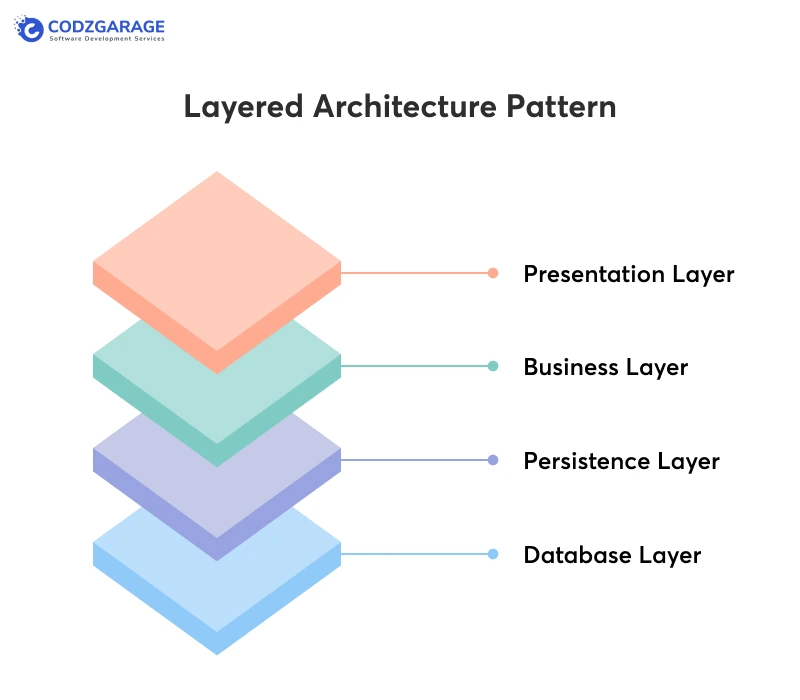
The Layered architecture, aka N-tier, is one of the most used patterns. Developers like this pattern because of its easy development and maintainability features. It divides an application into logical layers where one layer offers service to other layers. This pattern is widely used and the most standard practice for software product development lifecycle methodologies. In the Layered architecture, all the layers work together, but each is responsible for specific functionalities as a layer can interact only with the adjacent layer. This put more emphasis on modularity and separation of concerns.
The Benefits of Layered Pattern
- Layered patterns feature modularity which facilitates easier maintenance and updates.
- Each layer can interact with the adjacent layer only, and this clear separation of concerns improves code organization.
- Supports parallel development by enabling different teams to work on separate layers.
- With layered architecture patterns, developers can enhance the reusability of components.
- Each layer can communicate to adjacent only, which allows easy replacement or modification of layers without affecting others.
Shortcomings of Layered Pattern
- Overhead due to communication between layers.
- Adding new functionality might require changes across multiple layers.
- It may not be suitable for very small or highly dynamic applications.
- This can lead to performance bottlenecks if not designed carefully.
- Complex applications can result in a large number of layers, increasing complexity.
Best Use Cases of Layered Pattern
- Web applications that need business logic and data access layers.
- Enterprise applications that require clear separation of concerns.
- Applications with diverse layers, and each needs to be developed independently.
#2: Client-Server Architecture Pattern
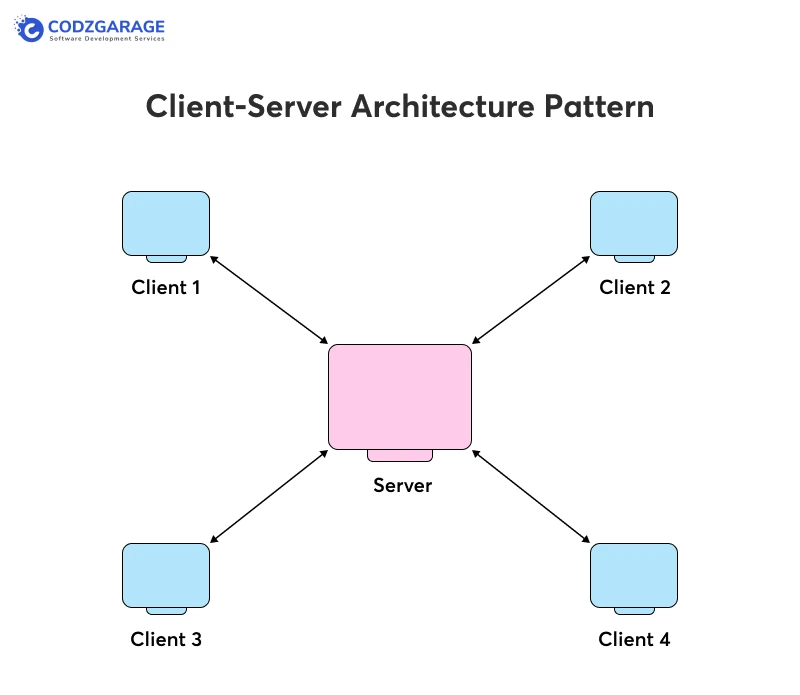
Want to create gaming applications? Or do you want to create an email system? Or is it a web application where the browser act as a client? The Client-Server pattern is the right choice for you. The application is divided into the client (requester) and the server (provider) in this pattern.
Picture this: a customer ordering food and a chef preparing food. The client seeks specific services, and the server offers those services through “ports.”
That means they communicate over a network. It’s like a virtual connection. This pattern is seen in the World Wide Web, where browsers (clients) request websites from servers. It’s also used for online tasks like file sharing and emails.
The Benefits of Layered Pattern
- Have centralized data management and control on the server.
- Allows clients to be lightweight, compatible with various devices.
- A single server becomes a source to multiple clients.
- Controlled data access on the server provides Intact security.
- Easy to update and maintain applications just by updating the server.
Shortcomings of Layered Pattern
- Application failure in case of a glitch in the server or if it goes down.
- Network dependency can lead to latency issues.
- Scalability challenges if the server becomes a bottleneck.
- It may require continuous communication, leading to increased network traffic.
- Complex interactions might lead to synchronization problems.
Best Use Cases of Layered Pattern
- Best for web applications where the browser acts as the client and the server handles data processing.
- Email systems, online banking services, file-sharing applications, etc., where clients retrieve emails and data from a central server.
- Suitable for Multiplayer online gaming applications or applications that require controlled access.
#3: Master-Slave Pattern
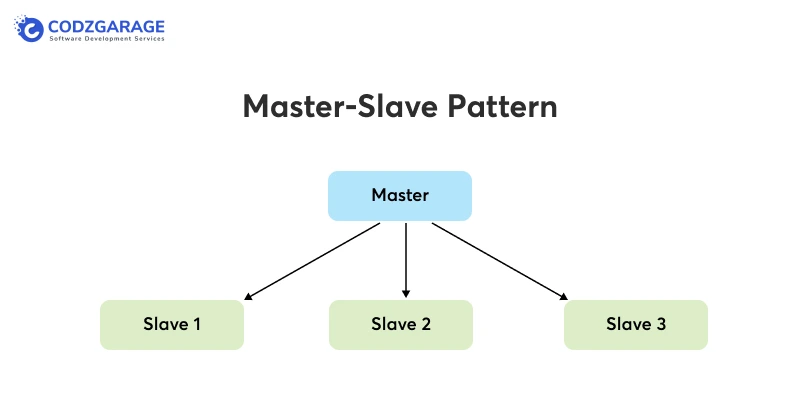
Master-slave architecture pattern, just like ‘the client-server pattern, consists of two components: one is called the controller, while the other is called the responder. They work together to improve the system’s reliability and performance. The Master-Slave pattern involves a central master component that controls and delegates when multiple similar requests are received simultaneously. The slave component, on the other hand, performs tasks as directed by the master.
The Benefits of Layered Pattern
- Efficient utilization of resources by distributing tasks by a master to salve component.
- Scalability as slave components can be added to handle multiple task requests simultaneously.
- Simplifies complex tasks by breaking them into smaller parts and processing them as requested.
- Supports parallel processing so that multiple similar requests can be responded to quickly.
Shortcomings of Layered Pattern
- Dependency on the master.
- Coordination challenges between master and slave components.
- Complex management of tasks
- No smooth communication between components.
- Latency issue.
- Potential performance degradation.
Best Use Cases of Layered Pattern
- Best choice for data processing systems.
- Distributed databases system.
- Image or video processing applications.
#4: Pipe-Filter Architecture Pattern
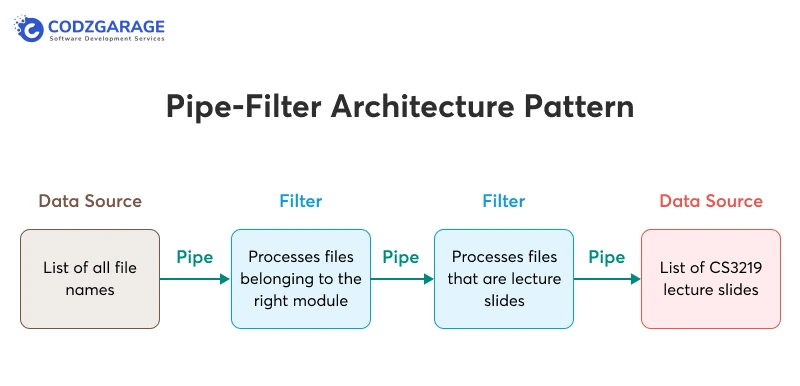
Pipes and Filters are the most famous architectural patterns with independent components called filters. The pattern connects a series of processing components (filters) through pipes. Data flows from one filter to the next, each filter performing a specific transformation.
The Benefits of Layered Pattern
- Modularity and reusability of filters.
- Enables efficient data processing by breaking it into sequential steps.
- Easy addition or modification of filters without affecting the entire pipeline.
- Supports parallel processing if filters are independent.
- Clear separation of concerns as each filter performs a specific task.
Shortcomings of Layered Pattern
- Performance issues in some instances.
- Limited interaction between filters may impact complex tasks.
- Changes challenges due to dependency
- Complex error handling and recovery.
- Overhead due to communication between filters.
Best Use Cases of Layered Pattern
- Feature-rich image processing applications.
- Data transformation that needs ETL (Extract, Transform, Load) processes.
- Audio or video streaming pipelines.
#5: Broker Architecture Pattern
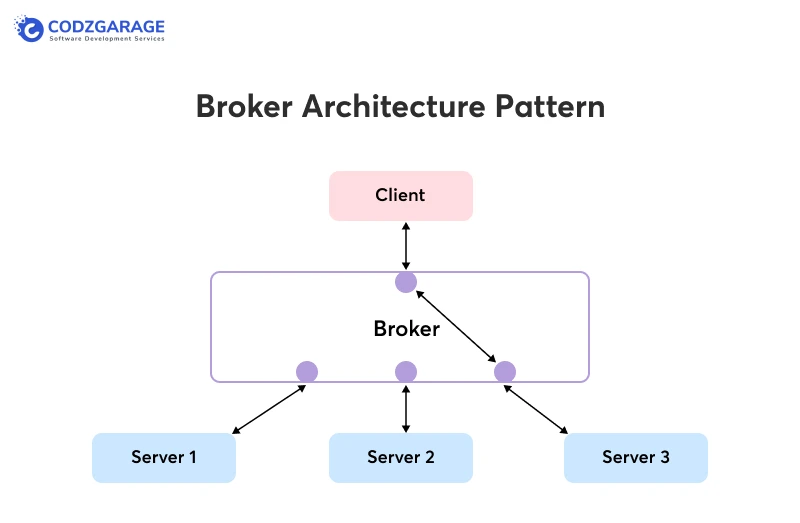
The Broker pattern introduces a central component (the broker) that acts as an intermediary to structure distributed software system. It’s best suitable for message queuing systems, albeit good for various applications. It coordinates communication and data exchange between different components.
The Benefits of Layered Pattern
- Centralized control and management of communication.
- Decouples components by abstracting communication details.
- It enables flexibility as components can interact without direct connections.
- Supports different communication models (publish-subscribe, request-response, etc.).
- Enhances security by controlling access to the broker.
Shortcomings of Layered Pattern
- Single point of failure if the broker goes down.
- Potential performance bottleneck if the broker becomes overloaded.
- Dependency on the broker for communication affects fault tolerance.
- Complex setup and configuration of the broker.
- Increased latency due to the involvement of the broker in every communication.
Best Use Cases of Layered Pattern
- Message queuing systems for asynchronous communication between services.
- IoT (Internet of Things) applications where devices communicate through a central hub.
- Event-driven architectures are where components react to events triggered by the broker.
How Does Codzgarage Help You Decide Software Architecture Patterns?
We are a leading custom software development company with core expertise in building high-quality custom software and migrating legacy software to new technologies and platforms. When you connect with us with your project scope, we help you select suitable software architecture patterns after evaluating your projects, industries, market, target audience, and requirements. We also help you build high-quality web and mobile applications that perfectly align with your business requirements.
Final Thoughts
In this article, we discussed everything about software architecture patterns and suggested some top-notch architecture patterns that can help you choose based on your requirements. If you want to explore more about this pattern and understand which one will suit your projects, connect with us and steadfast your project.
Want to
Hire Mobile App DevelopersOur Expertise
- Experienced team
- Multi-platform skills
- Dedicated resources






 Kevin Bhut
Kevin Bhut 







